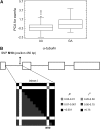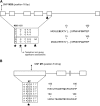Association genetics in Pinus taeda L. I. Wood property traits
- PMID: 17110498
- PMCID: PMC1775017
- DOI: 10.1534/genetics.106.061127
Association genetics in Pinus taeda L. I. Wood property traits
Abstract
Genetic association is a powerful method for dissecting complex adaptive traits due to (i) fine-scale mapping resulting from historical recombination, (ii) wide coverage of phenotypic and genotypic variation within a single experiment, and (iii) the simultaneous discovery of loci and alleles. In this article, genetic association among single nucleotide polymorphisms (58 SNPs) from 20 wood- and drought-related candidate genes and an array of wood property traits with evolutionary and commercial importance, namely, earlywood and latewood specific gravity, percentage of latewood, earlywood microfibril angle, and wood chemistry (lignin and cellulose content), was tested using mixed linear models (MLMs) that account for relatedness among individuals by using a pairwise kinship matrix. Population structure, a common systematic bias in association studies, was assessed using 22 nuclear microsatellites. Different phenotype:genotype associations were found, some of them confirming previous evidence from collocation of QTL and genes in linkage maps (for example, 4cl and percentage of latewood) and two that involve nonsynonymous polymorphisms (cad SNP M28 with earlywood specific gravity and 4cl SNP M7 with percentage of latewood). The strongest genetic association found in this study was between allelic variation in alpha-tubulin, a gene involved in the formation of cortical microtubules, and earlywood microfibril angle. Intragenic LD decays rapidly in conifers; thus SNPs showing genetic association are likely to be located in close proximity to the causative polymorphisms. This first multigene association genetic study in forest trees has shown the feasibility of candidate gene strategies for dissecting complex adaptive traits, provided that genes belonging to key pathways and appropriate statistical tools are used. This approach is of particular utility in species such as conifers, where genomewide strategies are limited by their large genomes.
Figures




Similar articles
-
Identification of quantitative trait loci influencing wood property traits in loblolly pine (Pinus taeda L.). III. QTL Verification and candidate gene mapping.Genetics. 2003 Aug;164(4):1537-46. doi: 10.1093/genetics/164.4.1537. Genetics. 2003. PMID: 12930758 Free PMC article.
-
DNA sequence variation and selection of tag single-nucleotide polymorphisms at candidate genes for drought-stress response in Pinus taeda L.Genetics. 2006 Mar;172(3):1915-26. doi: 10.1534/genetics.105.047126. Epub 2005 Dec 30. Genetics. 2006. PMID: 16387885 Free PMC article.
-
Quantitative trait loci influencing forking defects in an outbred pedigree of loblolly pine.BMC Genet. 2016 Oct 18;17(1):138. doi: 10.1186/s12863-016-0446-6. BMC Genet. 2016. PMID: 27756221 Free PMC article.
-
Association genetics of chemical wood properties in black poplar (Populus nigra).New Phytol. 2013 Jan;197(1):162-176. doi: 10.1111/nph.12003. Epub 2012 Nov 16. New Phytol. 2013. PMID: 23157484
-
Exploring the genetic basis of gene transcript abundance and metabolite levels in loblolly pine (Pinus taeda L.) using association mapping and network construction.BMC Genet. 2018 Nov 6;19(1):100. doi: 10.1186/s12863-018-0687-7. BMC Genet. 2018. PMID: 30400815 Free PMC article.
Cited by
-
Time to get moving: assisted gene flow of forest trees.Evol Appl. 2015 Aug 24;9(1):271-90. doi: 10.1111/eva.12293. eCollection 2016 Jan. Evol Appl. 2015. PMID: 27087852 Free PMC article. Review.
-
Carotenoid content and root color of cultivated carrot: a candidate-gene association study using an original broad unstructured population.PLoS One. 2015 Jan 23;10(1):e0116674. doi: 10.1371/journal.pone.0116674. eCollection 2015. PLoS One. 2015. PMID: 25614987 Free PMC article.
-
Single-nucleotide polymorphisms(SNPs) in a sucrose synthase gene are associated with wood properties in Catalpa fargesii bur.BMC Genet. 2018 Nov 1;19(1):99. doi: 10.1186/s12863-018-0686-8. BMC Genet. 2018. PMID: 30384853 Free PMC article.
-
The Genetic Architecture of Juvenile Growth Traits in the Conifer Torreya grandis as Revealed by Joint Linkage and Linkage Disequilibrium Mapping.Front Plant Sci. 2022 Jun 27;13:858187. doi: 10.3389/fpls.2022.858187. eCollection 2022. Front Plant Sci. 2022. PMID: 35832218 Free PMC article.
-
A candidate gene association study on muscat flavor in grapevine (Vitis vinifera L.).BMC Plant Biol. 2010 Nov 9;10:241. doi: 10.1186/1471-2229-10-241. BMC Plant Biol. 2010. PMID: 21062440 Free PMC article.
References
-
- Baskin, T. I., 2001. On the alignment of cellulose microfibrils by cortical microtubules: a review and a model. Protoplasma 215: 150–171. - PubMed
-
- Boerjan, W., 2005. Biotechnology and the domestication of forest trees. Curr. Opin. Biotechnol. 16: 159–166. - PubMed
-
- Boerjan, W., H. Meyermans, C. Chen, J. Christensen, J.-C. Leplé et al., 1999. Improved wood quality for the pulp and paper industry by genetic engineering of lignin biosynthesis. International Poplar Symposium II, September 13–17, 1999, Orleans, France.
Publication types
MeSH terms
Substances
LinkOut - more resources
Full Text Sources
Research Materials
Miscellaneous

